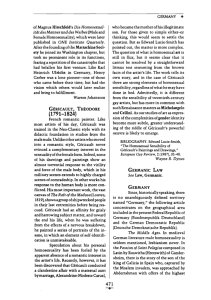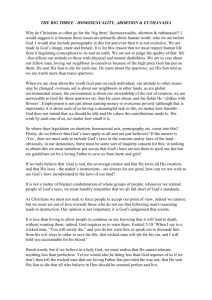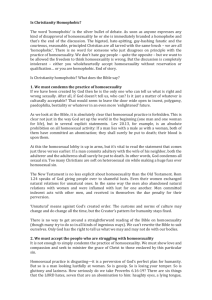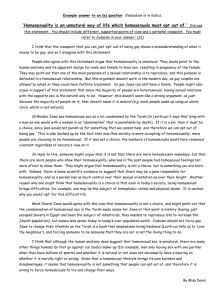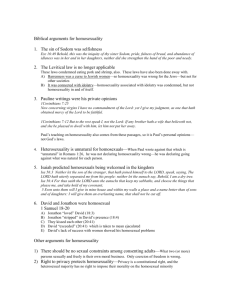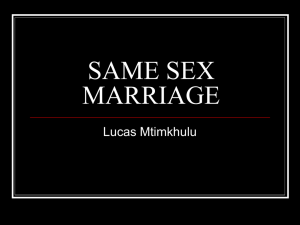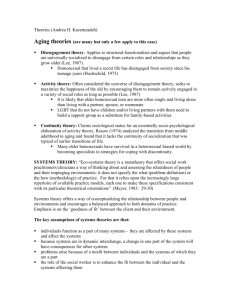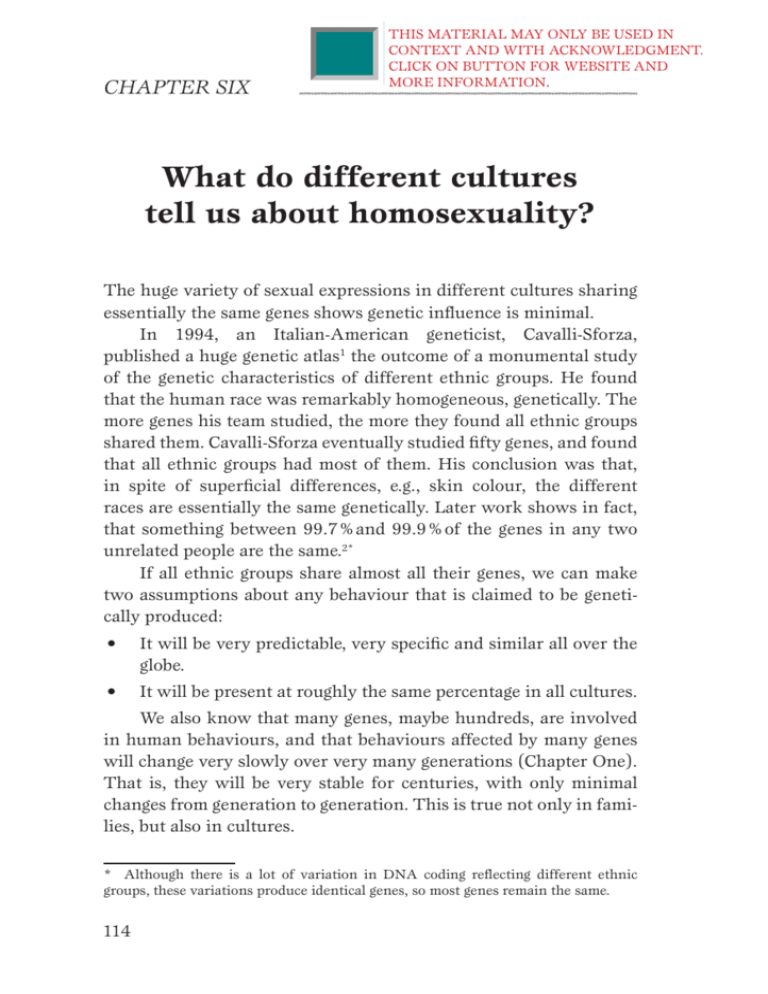
CHAPTER SIX
THIS MATERIAL MAY ONLY BE USED IN
CONTEXT AND WITH ACKNOWLEDGMENT.
CLICK ON BUTTON FOR WEBSITE AND
MORE INFORMATION.
What do different cultures
tell us about homosexuality?
The huge variety of sexual expressions in different cultures sharing
essentially the same genes shows genetic influence is minimal.
In 1994, an Italian-American geneticist, Cavalli-Sforza,
published a huge genetic atlas1 the outcome of a monu­mental study
of the genetic characteristics of different ethnic groups. He found
that the human race was re­markably homogeneous, genetically. The
more genes his team studied, the more they found all ethnic groups
shared them. Cavalli-Sforza eventually studied fifty genes, and found
that all ethnic groups had most of them. His conclu­sion was that,
in spite of superficial differences, e.g., skin colour, the different
races are essentially the same ge­netically. Later work shows in fact,
that something between 99.7%and 99.9%of the genes in any two
unrelated people are the same.2*
If all ethnic groups share almost all their genes, we can make
two assumptions about any behaviour that is claimed to be genetically produced:
•
It will be very predictable, very specific and similar all over the
globe.
•
It will be present at roughly the same percentage in all cultures.
We also know that many genes, maybe hundreds, are involved
in hu­man behaviours, and that behaviours affected by many genes
will change very slowly over very many generations (Chapter One).
That is, they will be very stable for centuries, with only minimal
changes from generation to generation. This is true not only in fami­
lies, but also in cultures.
* Although there is a lot of variation in DNA coding reflecting different ethnic
groups, these variations produce identical genes, so most genes remain the same.
114
Chapter Six: What do different cultures tell us about homosexuality?
But if we look at homosexuality, we find none of the characteristics of genetic properties.
•
There is a huge variety of homosexual practices between
cultures and even within them.
•
The prevalence of homosexuality has varied consid­erably in
different cultures. In some cultures, it has been unknown; in
others, it has been obligatory for all males.
•
There have been, and are, rapid changes in homo­
sexual
behaviour, even over a lifetime. Not only that, but entire types
of homosexuality have disappeared over the course of just a few
centuries.
In fact, anthropologists have found such huge varia­tions in heterosexual and homosexual practice from culture to culture, and such
sudden changes in sexual practice and orientation, even over a single
generation, that they mostly want to say that all sexual behaviour is
learned. In the words of one writer J. Rostand, “In the secret coming
together of two human bodies, all society is the third presence.”
Let’s first take a brief look at heterosexuality where a wide
variety of practices are already apparent.
Variations in heterosexual customs
In 1952, two anthropological researchers, Ford and Beach,3 reported
the results of a project organized by Yale University, that surveyed
190 different cultures in a very large cross­cultural study. There was
a wide range of heterosexual activity. There was no breast stimulation in six cultures, no kissing in nine, in two others sexual excitement was correlated with scratching or biting, in one urination was
part of foreplay, in another guest sex was practised (i.e., it was good
hospitality to offer your wife to a visi­tor). Among the Lepchas, all
young girls were sexually experienced by eleven or twelve, and even
as young as eight. Bestiality occurred only erratically in cultures; in
some it was unknown; in others, it was tolerated.
In a survey of preliterate cultures in 1971, Paul Gebhard4 of the
Kinsey Institute and member of the original Kinsey research team
noted that fetishism, voyeurism, exhibitionism, and well-developed
115
My Genes Made Me Do It!
sadomas­ochism were very rare or absent, appearing only in more
“advanced” societies.
What is sexually appealing in females depends on the culture.
In Arabic culture, a fat woman is beautiful. In ours, a slim but
well-rounded figure may be consid­ered desirable. A broad pelvis
is attractive in some cul­tures, a narrow one in others. In some
cultures, the shape of the mouth is particularly sexy. In our culture,
firm breasts are erotic, in others pendulous breasts, in others again
the breasts are not erotic at all. In Japanese culture, there is a much
greater erotic attraction to the nape of the neck and to older partners
than in ours.
Even a superficial look at heterosexuality reveals a range of
practices too broad to be genetically determined or strongly influenced.
Variations in homosexuality
We have established that a genetically induced ho­mosexuality would
tend to be fairly uniform in expres­sion throughout the world. But
neglecting minor variants two entirely different types of behaviour
co-existed historically—the Greek model and the Melanesian model—
and three co-exist today, t­he Greek model (secretly practised), the
Melanesian model, and the Western model.5 The variety of practices
outside these models, and even within the Western model, are also
quite at odds with a genetically prescribed ho­mosexuality.
The Greek Model
At the height of the Greek culture, according to the social custom,
an older married man was expected to take a younger boy as a kind
of squire and have sexual relations with him. Today, the West would
call him a bisexual pederast. The older man would act as a mentor
to the young boy and train him in manhood. He would even find
the young boy a bride when he reached mar­riageable age. Then he
would find another boy and start the process again. As described by
one scholar:6
This sort of Greek male’s ideal picture of himself was
that he serviced his wife, had a sexual friendship with
116
Chapter Six: What do different cultures tell us about homosexuality?
his mis­tress, and did his national duty by teaching
younger men how to behave with bravery and honorwhich more or less frequently involved buggering them
in an idealistic manner. It was only the boy he “‘loved.’”
In the Greek model, a boy starts out exclusively homosexual in
his relationship to his bisexual mentor, and then is strongly encouraged to become bisexual at maturity.
In Greek culture, homosexuality between adults—as we have
it in the West today—was considered despicable (mainly for the
receptive partner). One classical writer,5 talking of the mature male
who was also recep­tive, said, “we class those who enjoy the passive
part as belonging to the lowest depth of vice and allow them not the
least degree of confidence or respect or friendship.” Boys were not
denigrated for being receptive—it was appropriate to their status.
The Greek model7 was found in early imperial Greece, medieval
Persia, and at various times in China and Byzantium. It was found
in the Sudan, in feudal Japan among the Samurai, and in the Libyan
desert, where, fifty years ago males “talked about their masculine
love affairs as openly as they discussed their love of women.”3 The
Mameluke rulers of Egypt imported young boys from the Asian
steppes. The Aztecs and Mayans also subscribed to the Greek model.
According to one ac­count from the early 1900s, Arabic speakers
in North Morocco believed young boys would not learn the Koran
properly unless they had sexual relations with their teach­ers. Sexual
activity with boys or slaves was sometimes regarded as a right among
those with power and status. Amongst the Big Nambas in Vanuatu,
a father actively sought ‘guardians’ for his sons who would mentor
them and have sexual relationships with them.
The Melanesian Model
The Melanesian model8 is not well known in the West. In it, men pass
through three compulsory and sequential stages: passive exclusive
homosexuality, active exclusive homosexuality, and exclusive adult
heterosexu­ality. Many of the cultures practising it were in Papua
New Guinea, and perhaps the best known group was called the
Sambia (a pseudonym).
117
My Genes Made Me Do It!
like and
The Sambia believed that boys were naturally girl-­
would not develop manly qualities and sexual maturity unless they
ingested semen. The culture re­quired adolescents to fellate regularly
(often daily) young boys after they were taken from their mothers at
about age seven. When the boys reached the initiation rite at puberty,
they then had to repeat the process with younger boys as their social
duty. They continued to do this throughout adolescence, until they
reached marriage­able age. Then they had to stop all homosexual
activity, become exclusively heterosexual, and marry. Any man who
still wished to engage in homosexual activity with those of his own
age or younger was considered aber­rant, a “rubbish man.” (About
5% continued with the practice.) However two such radical shifts
in behaviour in one lifetime would not be possible if homosexual­ity
were genetically-mandated. One missionary familiar with the New
Guinean tribal cultures (Don Richardson) suggests the prescribed
homosexual behaviour among youth might have been insisted upon
by polygynous older men to keep youths away from the young girls
they wanted as their own wives. Many anthropologists believe an
extraordinary fear of contamination from women in this culture
may have contributed to the practice (i.e., mar­riage was considered
highly dangerous). Whatever the cause, anthropologists agree that it
was culturally man­dated.
The Melanesian model was found mostly in southern Papua New
Guinea, and in the islands to the northeast. Overall, some 10-20%of
Papua New Guinea cul­tures fell into this category. Sometimes the
sexual ex­pression was anal, sometimes oral. In some places, a youth
was not permitted to fellate his friend, but could fellate his potential
enemy. In others, boys were “grown” by friends within a group. In
the Marind, an older youth who practised pederasty on a younger
boy had to later marry that boy’s sister, a practice also followed by
the Etoro, Kiwai, and Keraki, except that in the latter two groups,
sodomy was practised rather than fellatio.
The Western Model
The Western male homosexual model5 is com­paratively recent and is
quite different from ei­ther the Greek or Melanesian models, which
institution­alized pederasty. The Western model is characterized by
118
Chapter Six: What do different cultures tell us about homosexuality?
exclusive homosexuality between adults, usually of ap­proximately
equal status, and an insistence that the behaviour is intrinsic. It is
also highly politicized.
The first appearances of the Western model appear to have been
adult homosexual networks in cities in France in the fifteenth and
sixteenth centuries; for lesbians, some records date from the late
1700. Mollyhouses in England, in the 1700s, appear to be an­other
pre-echo of modern homosexuality. These appear to have been
essentially “adults only” houses of male prostitution, in which the
receptive partners were very feminine in appearance. Homosexual
relations between adults do occur in the historical record before
that time, but the new element in the Western model is the relative
absence of bisexuality and pederasty. Historically, exclusive homosexuality was a very small fraction of bisexuality.
Greenberg5 a well known researcher of social contexts of
sexuality, comments that modern western homosexu­ality implies
that “erotic attraction originates in a rela­tively stable, more or less
exclusive attribute of the indi­vidual,” whereas in Western history
or in non-Western forms of homosexuality, “distinctions of age…
and so­cial status loom larger.” Modern lesbians, however, are uneasy
about agreeing homosexuality is intrinsic, prefer­ring in their commitment to the empowerment of women to see lesbianism as a choice.
In the West­ern model, a person identifies himself as “homosexual,”
though the word was coined only in the late 1800s.
The Western model tends to encourage promiscuity in males
(though AIDS has partially restrained this). A small subset of the
male culture encourages a “monogamous” relationship with another
adult, though usually with sub­stantial amounts of “recreational sex”
on the side. Bi­sexuality is often viewed as latent homosexuality;
there is strong pressure to make a choice to be exclusively homo­
sexual. Though sexual interest in pre-pubertal children is very minor
there is significant interest in young post-pubertal teenagers, as far
as is possible in Western countries, which universally proscribe it.
Lesbianism has, until recently, placed considerably higher emphasis
on sexual faithful­ness among partners, though there is a recent new
emphasis on sexual pleasure for its own sake. But even among the
119
My Genes Made Me Do It!
modern gay community, sexual expression varies from country to
country; anal intercourse is more popular in some than others.
The modern homosexual movement is so unusual that some
authors’ have talked about “the uniqueness and particularity of the
modern structuring of homo­sexuality into a gay world compared to
precapitalist forms.” For instance, in some cities, such as San Fran­
cisco, gays have created urban ghettoes—entire suburbs in which
gays live and provide a full range of gay profes­sional, social, and
sexual services.
Rotello17 a gay man, in a thought-provoking survey argues that
the Western model essentially originated between World War II
and about 1970. He mentions that before the war it was medically
considered that same-sex relations were safer than opposite-sex relationships with prostitutes —rates of sexually transmitted disease
were higher in the latter. Now, it has reversed. He says, “Few groups
in history appear to have changed their overall sexual behaviour as
rapidly and profoundly as homosexual American men in the decades
before AIDS”. He describes it as “a culture of unprecedented sexual
extremism”. Although he says “many have less than total control over
what they are doing” he is not arguing this is genetically mandated,
but implying it is a cultural shift.
The Western model is, therefore, nearly unique his­torically. Its
appearance has been too sudden, its evolution too swift, and spread
too considerable to have been genetically produced. Its low occurrence in some cultures, such as Arabic-speaking cultures (which
more usually reflect the Greek model), is also inconsistent with a
genetically prescribed condition. The lesson of history and culture is
that cultural homosexuality is self-taught.
Summary
These three coincident homosexual streams, each very different
from the other, in a context in which humankind shares more than
99% of its genes, means homosexuality does not conform to any
genetically prescribed model. In a genetic model, homosexual behaviours would be practically identical.
Not only are there quite different models—the Greek, Melanesian, and Western—co-existing today, but there are a myriad of other
120
Chapter Six: What do different cultures tell us about homosexuality?
homosexual customs and prac­tices, not the behavioural uniformity
associated with a ge­netically dictated homosexuality.
More permutations...
For other cultural variations see the references7,9,10,11,12. Many of these
are not just variations in individuals but in whole people-groups.
They are minor models, but extremely varied. They included the
Berdache, a kind of third sex among USA native Americans. Lesbian
variations were much less common and Ford and Beach3 recorded
only 17 cultures in which that behaviour was known at all, and the
behaviours were all quite different.
Cultures without homosexuality
If homosexuality were significantly influenced, let alone dictated
by genes, it would appear in every cul­ture, but in 29 of 79 cultures
surveyed by Ford and Beach in 1952,3 homosexuality was rare or
absent. It was very rare in the Siriono, even though there were no
prohibitions on homosexual relationships in that culture. The researcher observed only one man display­ing slight homosexual traits
but apparently not sexually involved with another man. Homosexuality appears to be historically rare among Orthodox Jews,13 so much
so that learned rabbis, the interpreters of Jewish law, usually allowed
men to sleep in the same bed, because likelihood of sexual contact
was considered negligible. Kinsey also found very low homosexual
incidence among Orthodox Jews.14
Some anthropologists have questioned Ford and Beach’s
findings, believing that irregular sexual intimacy is not something
foreign researchers can easily get infor­mation about. One sexual
anthropologist, Whitam,15 thought homosexuality must be genetically enforced because he found it practised in some isolated groups
in South America and East Asia who knew nothing of the practice
elsewhere.
But evidence from other remote tribes in New Guinea—all
genetically related—suggests differently. This evidence comes from
missionaries who commonly spend decades living in one culture, far
more than almost any anthropologist. The anthropologist will argue
121
My Genes Made Me Do It!
that the sexual practices will never be admitted to missionaries; on
the other hand it could be argued that missionaries will be unusually
sensitive to practices transgressing Christian teaching. Overall they
can be considered as reliable witnesses. For example, in contrast to
groups like the Sambia in the New Guinea highlands, where homosexuality was com­pulsory, only about 2-3%of Western Dani (also in
the New Guinea highlands) practiced it. However, in another group
of Dani who were closely genetically related, ho­mosexuality was
totally unknown. Missionaries report that when they were translating the Bible into Dani for this group, their tribal assistants, who
knew their own culture intimately, were nonplussed by references
to homosexu­ality in Romans 1; they did not understand the concept.
Another missionary, with the same group for 25 years, overheard
many jests and sexually ribald exchanges among the men, but never
a single mention of homo­sexuality in all that time. One missionary
boy was brought up in a Dani group among the Dani young people
for many years, knew the culture and language far better than any
anthropologist, or his parents, and who contrary to the standards of
his parents was sexually involved, also testifies to the lack of adult
homosexuality and says he would have known about it.
When Dani went to help with missionary work among the
Sambia, they were astounded at some of the homosexual practices
they saw for the first time. Although it is always difficult for a
foreigner to be completely sure whether a rare and stigmatised
behaviour exists, it is certainly true if three such differ­ent experiences of homosexuality can occur in groups of people so closely
related genetically, 100% genetic determin­ism of homosexuality is
an impossibility.
Sudden changes
We have mentioned that human behaviours associated with many
genes change slowly over many generations or centuries. But history
shows us that homosexual prac­tice has disappeared quite suddenly—
in some cases over a couple of generations—as the culture has
changed. For example, there were many berdaches among the North
American Crows in 1840, but by 1900 only one was left. Among the
Potowatami, there was a huge de­crease in berdaches between 1870
122
Chapter Six: What do different cultures tell us about homosexuality?
and 1930. The trans­vestite Koniags of Kodiak Island disappeared
between 1800 and 1850. The “men turned women” (manang bali) of
Borneo were common in 1850, rare in 1911, and are now unknown.
The Samurai pederastic practices vanished long ago. Among the
Aymara (South American), the homosexuality, lesbianism, and
transvestism recorded in historical times has now disappeared.
Tahitian mahus are far less common now than in the late eighteenth
century. Anthropologists attribute many of the changes to Christian
influence. In some cases, homosexuality dis­appeared so rapidly that
accurate information on homo­sexual practices was hard to collect.
The customs of the Sambia vanished, under missionary teaching,
about 1984. Even at the height of the Sambian pederastic culture,
the sudden change required of men of marriageable age from homosexuality to heterosexuality argued against its being genetically
innate, and in favour of a substantial cultural basis to homosexual
orientation and practice.
But change was not always missionary-mediated. Men’s houses,
besides being homosexual hot-houses, were also venues for planning
war raids. In some cases, the government stepped in and simply
closed the houses down, sometimes jailing offenders. This worked;
it also completely disrupted and contributed to the disappear­ance of
pederastic activity in a few years.
The Greek model (cultural pederasty), after becoming popular
in Rome, disappeared slowly with time as the culture absorbed
several ascetic philosophies. There was a further decline after the
Christianisation of the Roman Empire. But even this change over a
few centu­ries was probably too sudden for a genetically dominated
behaviour. The sudden rise and disappearance of lesbian practices,
such as the Pearl River communities in China and the “Mummies
and Babies” movements in southern Africa, were incompatible with
any genetic model.
Even within the modern gay scene, there have been changes
in practice, which have been far too swift for anything genetically
induced. Fisting (insertion of the hand into the rectum) was virtually
unknown in the forties and fifties, but a large minority of gays (at
least in San Francisco16) have now experienced it at least once, and
the practice has spread to lesbians with both anal and vaginal expres123
My Genes Made Me Do It!
sion. Feminine mannerisms have de­creased among male homosexuals, and a recent trend has been an exaggerated maleness.
Another trend has been a huge increase in homosexual experimentation by heterosexuals documented, for example, in the Netherlands18 and in New Zealand (women).19
By 2010 the Western Model, in spite of catastrophes like AIDS,
seemed fairly well established, and had persuaded itself it was innate.
Summary
When Greenberg comments5 that “it is reasonable to suppose that
if a bunch of Melanesian infants were to be transported in infancy
to the United States and adopted, few would seek out the pederastic relationships into which they’re inducted in New Guinea,” he
summarizes the essence of this chapter. If sexual behaviour were
geneti­cally driven, the Melanesian infants would seek out pederastic
relation­ships in their new culture.
The diversity in homosexual activity in different cul­tures also
argues against genetic enforcement. If homo­sexuality were genetically mandated, the type of homo­sexual behaviour would be tightly
defined by the genes involved and almost uniform in all cultures.
If we want to argue genetic homosexuality, Vines2 report that the
human race shares more than 99.7%of its genes, means that of the
22,500 human genes in the human genome, between 23 and 70 genes
would have to account for all the variation in homosexual practice
that exists globally, in addition to all other non-sexual differences.
This is highly unlikely—probably impossible.
If homosexuality were genetic in origin, it would appear at about
the same percentage in all cultures. But this is clearly not so. Among
the genetically related tribes of the New Guinea Highlands, homosexuality was simul­taneously practiced as mandatory pederasty among
the Sambia, was unknown in another group even as a con­cept, and
practised by 2-3%of a closely related group. A significant number of
cultures appear not to have prac­tised homosexuality at all.
The rate of change of homosexual practice also ar­gues against
genetic causation. Slight changes in practice would appear over 1000
years if there were some strong genetic pressure for it, but not the
extensive decline of whole models over several centuries (e.g. the
124
Chapter Six: What do different cultures tell us about homosexuality?
Greek model), not the entire disappearance of homosexuality from
some cultures over several generations, and cer­tainly not the very
sudden 30-year rise of the modern West­ern model, with characteristics so different from its pre­decessors, and its own swiftly changing
practices. The latter is the least likely to be ‘genetic.’
The expression of homoerotic desire does not seem to be genetically imprinted. Sexuality appears to have an overwhelmingly
cultural component, ebbing and flowing with changes in cultural
values and expecta­tions. Certain sexual expressions may be historical phe­nomena which flourish for a time because of particular circumstances, and then cease, e.g. Pearl River lesbian­ism which ceased
in 1935. Pederastic homosexuality can be culturally man­dated, as
among the Sambia, or culturally proscribed, as in the West.
When anthropologists survey the evidence, they are, to a surprising degree, united in the belief that behaviours such as homosexuality and lesbianism are not pro­duced genetically, but by social
conditions. If they tried to put a figure on the genetic content of
homosexuality, most of them would probably argue for something
near zero.
Did their genes make them do it? Not according to the anthropologists.
125
My Genes Made Me Do It!
References
1. Cavalli-Sforza LL, Menozzi P, Piazza A. 1994. The History and Geography of
Human Genes. Princeton, New Jersey: Princeton University Press
2. Vines G. 1995. Genes in black and white. New Scientist 147(July 8):34-7
3. Ford CS, Beach FA. 1952. Patterns of Sexual Behaviour. London: Eyre and
Spottiswoode
4. Gebhard PH. 1971. Human Behavior: Variations in the Ethnographic Spectrum.
New York: Basic Books
5. Greenberg DF. 1988. The Construction of Homosexuality. Chicago: The University
of Chicago Press
6. Seymour-Smith M. 1975. Sex and Society. London: Hodder and Stoughton
7. Adams BD. 1986. Age, structure, and sexuality-reflections on the anthropological
evidence on homosexual relations. In The Many Faces of Homosexuality:
Anthropological Approaches to Homosexual Behavior, ed. Blackwood E, 19-33
pp. New York: Harrington Park Press
8. Herdt GH. 1981. Guardians of the Flutes. Idioms of Masculinity. New York:
McGraw-Hill
9. Fry P. 1986. Male homosexuality and spirit possession in Brazil. In The Many
Faces of Homosexuality: Anthropological Approaches to Homosexual Behavior,
ed. Blackwood E, 137-153 pp. New York: Harrington Park Press
10. Callender C. 1986. Men and non-men—Male gender-mixing statuses and
homosexuality. In The Many Faces of Homosexuality: Anthropological
Approaches to Homosexual Behavior, ed. Blackwood E, 165-178 pp. New York:
Harrington Park Press
11. Sankar A. 1986. Sisters and brothers, lovers and enemies-marriage resistance in
Southern Kwangtung. In The Many Faces of Homosexuality: Anthropological
Approaches to Homosexual Behavior, ed. Blackwood E, 69-81 pp. New York:
Harrington Park Press
12. Gay J. 1986. “Mummies and Babies” and friends and lovers in Lesotho. In The
Many Faces of Homosexuality: Anthropological Approaches to Homosexual
Behavior, ed. Blackwood E, 97-116 pp. New York: Harrington Park Press
13. Prager D. 1990. Judaism, homosexuality and civilization. Ultimate Issues 6(2):24
14. Kinsey AC, Pomeroy WB, Martin CE. Sexual Behavior in the Human Male. 1948.
Philadelphia, W.B.Saunders
15. Whitam FL, Mathy RM. 1986. Male Homosexuality in Four Societies. Brazil,
Guatemala, the Philippines, and the United States. New York: Praeger
16. Cameron P. 1992. Medical Consequences of What Homosexuals Do. Washington,
DC: Family Research Council
17. Rotello G. 1997. Sexual Ecology. AIDS and the Destiny of Gay Men.
Harmondsworth, Middlesex, UK: Dutton
18. Kuyper L, Vanwesenbeeck I. 2009. High levels of same-sex experiences in
the Netherlands: prevalences of same-sex experiences in historical and
international perspective. Journal of Homosexuality 56(8):993-1010
19. Dickson N, Paul C, Herbison P. 2003. Same-sex attraction in a birth cohort:
prevalence and persistence in early adulthood. Social Science and Medicine
56, 1607-1615
126

